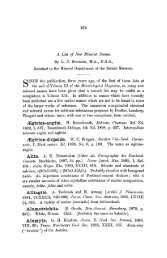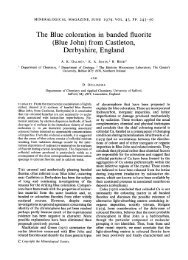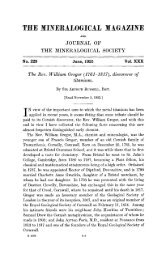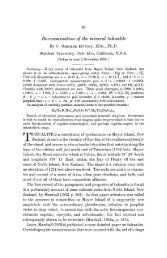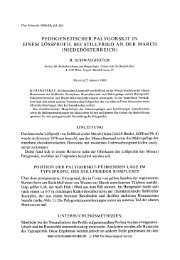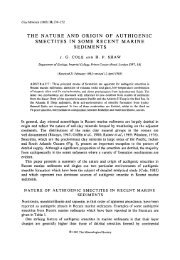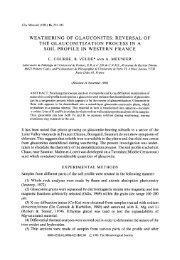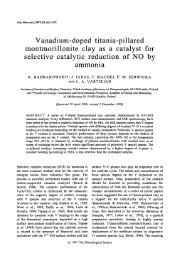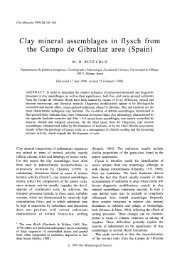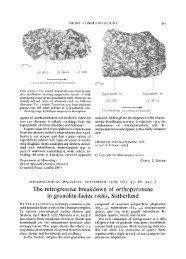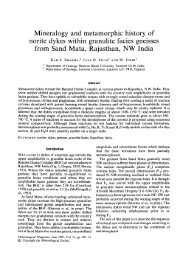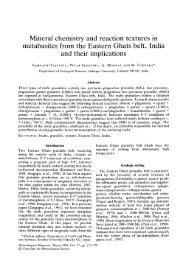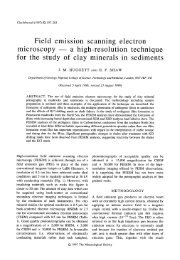Amblygonite in leucogranites of the Tregonning-Godolphin Granite ...
Amblygonite in leucogranites of the Tregonning-Godolphin Granite ...
Amblygonite in leucogranites of the Tregonning-Godolphin Granite ...
You also want an ePaper? Increase the reach of your titles
YUMPU automatically turns print PDFs into web optimized ePapers that Google loves.
SHORT COMMUNICATIONS I51<br />
MINERALOGICAL MAGAZINE, MARCH I978, VOL. 4 2, PP. I5I-2<br />
<strong>Amblygonite</strong> <strong>in</strong> <strong>leucogranites</strong> <strong>of</strong> <strong>the</strong><br />
Tregonn<strong>in</strong>g-Godolph<strong>in</strong> <strong>Granite</strong>, Cornwall<br />
EARLIER papers (Exley and Stone, 1966; Stone,<br />
1975) have referred briefly to <strong>the</strong> occurrence <strong>of</strong> a<br />
m<strong>in</strong>eral presumed to be amblygonite (ma<strong>in</strong>ly<br />
LiA1PO,F) <strong>in</strong> west Cornwall. Tentative identifica-<br />
tion was based upon observations <strong>in</strong> th<strong>in</strong> section<br />
and <strong>the</strong> large amounts <strong>of</strong>Li, AI, P, and F <strong>in</strong> <strong>the</strong> host<br />
rocks. This note confirms its first reported occur-<br />
rence <strong>in</strong> Cornwall.<br />
Identification. A heavy m<strong>in</strong>eral suite hav<strong>in</strong>g a<br />
density between those <strong>of</strong> brom<strong>of</strong>orm (2'89 g cm- 3)<br />
and di-iodomethane (3"33 g cm-3) was separated<br />
from <strong>the</strong> IOO-I5O /~m gra<strong>in</strong>-size fraction <strong>of</strong> <strong>the</strong><br />
crushed rock. This suite <strong>in</strong>cluded tourmal<strong>in</strong>e, apa-<br />
tite, topaz, and a milky-white m<strong>in</strong>eral presumed to<br />
be amblygonite. Tourmal<strong>in</strong>e was removed us<strong>in</strong>g a<br />
Cook magnetic separator. The milky-white m<strong>in</strong>eral<br />
was concentrated fur<strong>the</strong>r by float<strong>in</strong>g <strong>the</strong> separated<br />
fraction on di-iodomethane and dilut<strong>in</strong>g with ace-<br />
tone <strong>in</strong> successive steps. F<strong>in</strong>al handpick<strong>in</strong>g <strong>of</strong> <strong>the</strong><br />
milky-white m<strong>in</strong>eral, leav<strong>in</strong>g a residue <strong>of</strong> topaz and<br />
a little apatite, gave <strong>the</strong> fraction that was sub-<br />
sequently X-rayed us<strong>in</strong>g a II4"6 mm diameter<br />
Debye-Scherrer diffraction camera with Cu-K~<br />
radiation.<br />
The X-ray pattern conforms closely with that <strong>of</strong><br />
amblygonite given by (2ernfi, t~ern~, and Ferguson<br />
(i973) and <strong>in</strong>dex<strong>in</strong>g was achieved by compari-<br />
son with <strong>the</strong> published data. The cell parameters<br />
were determ<strong>in</strong>ed by submitt<strong>in</strong>g <strong>the</strong> whole pattern<br />
to a standard regression computer program and<br />
are (error stated at one standard deviation): a =<br />
5'I4+O'OI A, b = 7'21 +0"01 /~, c = 5"O6+O'OZ A,<br />
V=158.O+0. 4 ,~3, ct=ii3.9+o.lO, /3=98. 6<br />
+O'I ~ 7=67"3+O'~ ~ Estimates based upon<br />
<strong>the</strong>se figures us<strong>in</strong>g <strong>the</strong> regression equations <strong>of</strong><br />
~erna et al. (1973), but with <strong>the</strong> b parameter<br />
omitted ow<strong>in</strong>g to an impossibly high result ob-<br />
ta<strong>in</strong>ed from it, and round<strong>in</strong>g <strong>the</strong> results to whole<br />
numbers, give an average weight percentage <strong>of</strong> F as<br />
12 + 2 (at two standard deviations with six results).<br />
Small errors <strong>in</strong> <strong>the</strong> cell parameters can result <strong>in</strong><br />
large differences <strong>in</strong> <strong>the</strong> f<strong>in</strong>al result. However, even<br />
at <strong>the</strong> worst error, if all values gave lower results by<br />
two standard deviations <strong>of</strong> <strong>the</strong> figure for each cell<br />
parameter (a most unlikely situation), <strong>the</strong> average<br />
weight percentage <strong>of</strong>F is over 7- Hence <strong>the</strong> data are<br />
consistent with a composition with<strong>in</strong> <strong>the</strong> ambly-<br />
gonite part <strong>of</strong> <strong>the</strong> amblygonite-montebrasite series<br />
(Moss, Fejer, and Embrey, 1969; (2ernh et al., I973).<br />
The value <strong>of</strong> <strong>the</strong> specific gravity (determ<strong>in</strong>ed with<br />
a pycnometer) <strong>of</strong> 3.I4+o.o4 (at two standard<br />
deviations) is a little higher than that for pure<br />
amblygonite (3-II <strong>in</strong> (~ern~. et al., I973) and may<br />
reflect <strong>in</strong>complete separation from topaz.<br />
Occurrence. A study <strong>of</strong> <strong>the</strong> petrology <strong>of</strong> <strong>the</strong><br />
Tregonn<strong>in</strong>g-Godolph<strong>in</strong> granite complex (Stone,<br />
I975) has shown that, with <strong>the</strong> exception <strong>of</strong> <strong>the</strong><br />
biotite-bear<strong>in</strong>g Godolph<strong>in</strong> granite, most <strong>of</strong> <strong>the</strong><br />
rocks carry lithium mica, probably lepidolite by<br />
analogy with similar rocks at Meldon (Chaudhry<br />
and Howie, 1973), and topaz and albite and are<br />
quite markedly enriched <strong>in</strong> Na, Li, Rb, Cs, P, Nb,<br />
Ge, Sn, and F (Stone, <strong>in</strong> preparation). These rocks<br />
<strong>in</strong>clude <strong>the</strong> Tregonn<strong>in</strong>g granite and its overly<strong>in</strong>g<br />
ro<strong>of</strong> zone and associated marg<strong>in</strong>al granitic sheets.<br />
The ro<strong>of</strong> rocks and <strong>the</strong> sheets are composed <strong>of</strong><br />
<strong>leucogranites</strong>, aplites, and pegmatites, toge<strong>the</strong>r<br />
with tourmal<strong>in</strong>e-rich granite bands and occasional<br />
greisen bands. <strong>Amblygonite</strong> occurs <strong>in</strong> samples <strong>of</strong><br />
leucogranite obta<strong>in</strong>ed from <strong>the</strong> ro<strong>of</strong> at Carn<br />
Clodgy, near R<strong>in</strong>sey (Grid. ref. SW. 594269), and<br />
from <strong>the</strong> sheets at <strong>the</strong> Megiliggar Rocks (Grid. ref.<br />
SW. 61o266): it has not been observed so far <strong>in</strong> <strong>the</strong><br />
closely associated aplites and pegmatites or <strong>in</strong> <strong>the</strong><br />
Tregonn<strong>in</strong>g granite.<br />
The <strong>leucogranites</strong> are millimetre-gra<strong>in</strong>ed (I mm<br />
to 3 mm gra<strong>in</strong> diameters typical) hypidiomorphic<br />
equigranular rocks. Modes <strong>of</strong> two samples that<br />
conta<strong>in</strong> amblygonite are given <strong>in</strong> Table I. The<br />
excess <strong>of</strong> euhedral to subhedral albite over anhed-<br />
ral potash feldspar produces <strong>the</strong> hypidiomorphic<br />
appearance. Tourmal<strong>in</strong>e is commonly pale yellow<br />
(<strong>in</strong> th<strong>in</strong> section) and poikiloblastic; it sometimes<br />
ve<strong>in</strong>s <strong>the</strong> feldspars. Subhedral to euhedral topaz<br />
would appear to be rich <strong>in</strong> F: measurements <strong>of</strong> <strong>the</strong> b<br />
cell parameter (8'79_o-oi /~) and cell volume<br />
(342 + I A 3) substituted <strong>in</strong> <strong>the</strong> regression equations<br />
<strong>of</strong> Ribbe and Rosenberg (I971) <strong>in</strong>dicate a compo-<br />
sition fairly close to <strong>the</strong> upper limit <strong>of</strong> F <strong>in</strong> <strong>the</strong><br />
F, OH sites.<br />
<strong>Amblygonite</strong> has an irregular distribution. It<br />
tends to occur as <strong>in</strong>terstitial gra<strong>in</strong>s measur<strong>in</strong>g 0-2 to<br />
just over 4"o mm across and commonly as isolated<br />
optically cont<strong>in</strong>uous pieces measur<strong>in</strong>g c. o'5 mm
I52 SHORT COMMUNICATIONS<br />
TABLE I. Amb l ygonite-bear<strong>in</strong>g rocks<br />
A. Modes 1 2 B. Chemical 3 4 5<br />
analyses<br />
Volume % Wt. %<br />
Quartz 24"7 24'2 SiO2 7v7 71"8 72.8<br />
K-feldspar 18.0 19'o TiO2 o'03 0-03 0'04<br />
Albite 4o'7 42-5 A1203 16. i 16. I 16. 4<br />
Mica Fe203 o. io o'o7<br />
(lepidolite) IO.8 9"4 WeO 0.42 o-38 o.84"<br />
Tourmal<strong>in</strong>e o.6 o.2 MnO o. I I o- lO 0'o9<br />
Topaz 4"6 2"5 MgO o'o4 o'o3 o'05<br />
<strong>Amblygonite</strong> o-2 1. 7 CaO o.24 o.21 1.28<br />
Apatite trace trace Na20 4"75 5-06 2"77<br />
O<strong>the</strong>rs 0"4 0"5 K20 3"71 4"04 3"95<br />
LizO o'57 o.51 0-94<br />
Ioo.o IOO.O P205 o'63 0"73 o'48<br />
F 1.74 1.4I I-4O t<br />
No. <strong>of</strong> sections<br />
(2-3 cm 2 area) 4 3<br />
* Total iron as Fe20 3. t Analysis by R. Fuge.<br />
I and 3: <strong>Amblygonite</strong>-bear<strong>in</strong>g leucogranite, Megiliggar Rocks (MSoo4o).<br />
2 and 4: <strong>Amblygonite</strong>-bear<strong>in</strong>g leucogranite, Carn Clodgy (amended version <strong>of</strong> analysis given <strong>in</strong> Exley and Stone,<br />
1966, Table 8, col. I) (MSoo44).<br />
5: Meldon microgranite from western end <strong>of</strong> quarry (MSo33o).<br />
Analysts: M. Stone and D. L Dallow.<br />
across. <strong>Amblygonite</strong> sometimes shows alteration to<br />
f<strong>in</strong>e-gra<strong>in</strong>ed lamellar aggregates (probably clay)<br />
and is commonly partly replaced by white mica.<br />
Fresh samples show typical f<strong>in</strong>e lamellar tw<strong>in</strong>n<strong>in</strong>g<br />
and occasionally a second set <strong>of</strong> lamellar tw<strong>in</strong>s.<br />
Chemical analyses <strong>of</strong> two <strong>leucogranites</strong> conta<strong>in</strong>-<br />
<strong>in</strong>g amblygonite are compared with a new analysis<br />
<strong>of</strong> <strong>the</strong> Meldon microgranite <strong>in</strong> Table I. K<strong>in</strong>gsbury<br />
(I966) reports f<strong>in</strong>d<strong>in</strong>g amblygonite <strong>in</strong> pegmatite <strong>in</strong><br />
<strong>the</strong> Meldon microgranite; this occurrence, toge<strong>the</strong>r<br />
with those occurrences reported from west<br />
Cornwall <strong>in</strong> this note, conform with <strong>the</strong> com-<br />
parable enrichment <strong>of</strong> all <strong>the</strong>se rocks <strong>in</strong> Li, P, AI,<br />
and F.<br />
Acknowledgement. We express our thanks to <strong>the</strong><br />
Pr<strong>of</strong>essor <strong>of</strong> Physics <strong>of</strong> <strong>the</strong> University <strong>of</strong> Exeter for k<strong>in</strong>dly<br />
allow<strong>in</strong>g <strong>the</strong> use <strong>of</strong> X-ray equipment <strong>in</strong> his Department.<br />
REFERENCES<br />
(2emil (I.), (~ern~, (P.), and Ferguson (R. B.), I973. Am.<br />
M<strong>in</strong>eral. 58, 29I-3oi.<br />
Chaudhry (M. N.) and Howie (P. A.), 1973. M<strong>in</strong>eral. Mag.<br />
39, 289-96.<br />
Exley (C. S.) and Stone (M.), I966 (for 1964). Present views<br />
on some aspects <strong>of</strong> <strong>the</strong> geology <strong>of</strong> CornwaU and Devon;<br />
eds. K. F. G. Hosk<strong>in</strong>g and G. J. Shrimpton. R. Geol. Soc.<br />
Cornwall, I5oth Anniversary Vol., I31-84.<br />
K<strong>in</strong>gsbury (A. W. G.), 1966 (for I964). Ibid. 249.<br />
Moss (A. A.), Fejer (E. E.), and Embrey (P. G.), 1969.<br />
M<strong>in</strong>eral. Mag. 37, 414-22.<br />
Ribbe (P. H.) and Rosenberg (P. E.), 1971. Am. M<strong>in</strong>eral.<br />
56, I812-2I.<br />
Stone (M.), ~975. Proc. Geol. Assoc. 86, I55-7o.<br />
[Manuscript received 25 January 1977;<br />
revised 5 September 1977]<br />
Copyright <strong>the</strong> M<strong>in</strong>eralogical Society<br />
Department <strong>of</strong> Geology, University <strong>of</strong> Exeter MAURICE STONE<br />
North Park Road, Exeter EX4 4QE MICHAEL C. GEORGE



